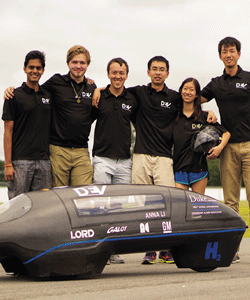As the last months of Patrick Grady’s time at Duke wound down, and then the spring turned into summer and endless eighty-five-hour weeks in the Gross Hall basement’s cluttered and flourescent makerspace, his faith came from the formulas. “The math said that we could beat [the record], said Grady ’18, the then-president of Duke Electric Vehicles, “but there was a big gap between the math saying that and actually doing that.”
Yet by the third week of July, after a 4 a.m. wakeup call to beat the North Carolina heat, the groggy team of engineers had managed to open a different gap: between the old world record for fuel efficiency and the standard their own vehicle set. Smashing the previous standard by 13 percent, the club had its own place in the Guinness record books.
Previously, Duke Electric Vehicles was a smaller, more laidback organization; the appeal was in testing different theoretical designs with MATLAB software, or even just building the vehicles in the Foundry (the basement makerspace in Gross Hall), assembling the electronics with a soldering iron and cutting fiberglass to match a foam mold of the car body. At the Shell Eco-Marathon Americas competition each spring, they’d take notes from the best-in-class, trailing in the wake of those teams before trying what Grady calls “a much more motivated approach” and breaking through in 2017 with their first-ever victory.
The team blazed into the 2017-2018 school year with even higher hopes. They broke down the vehicle into its various subcomponents, the seventeen students working in small groups to optimize the steering, propulsion system, aerodynamics, and more—leaning into the analysis to find the greatest efficiency.
It was a constant balancing act. “It’s really easy to chase one thing to the end of the Earth, and then you have two or three other things that have really obvious, gaping holes in them,” Grady says. The team added a “cost sensitivity” metric to make sure they weren’t overpaying for mere marginal improvements.
Perhaps the biggest gains came from the design of the car’s hydrogen fuel cell, a process led by seniors Gerry Chen and Shomik Verma, informed by their yearlong independent- study project. “I just wanted to get a fuel cell working for the competition, and I thought in future years we could build upon it, make it more efficient, and then go for a world record,” says Verma. “But when we saw how well the car was performing…as the year went on, our expectations changed and our goals for the year changed as well.”
In April, the team ran away with the Shell contest, the car so beyond that of the competition that other teams had—in a role reversal—started taking notes of Duke’s design, Grady says. They didn’t yet have the record, but the numbers were close enough for some team members to keep arguing over micro-efficiencies on many summer evenings in Gross Hall.
To enter the Guinness book, the car would have to travel an average of (at least) 15 miles per hour for 8.5 miles, inevitably along an “accelerate, cruise, accelerate, cruise” pattern, explains Verma. The team added a supercapacitor bank to harness the excess energy from the acceleration periods, enabling the use of a smaller fuel cell. They shrank the hydrogen tank. And the team employed riskier—but potentially faster—tires and wheel hubs.
By mid-July, the team was ready for the trek to GALOT Motorsports Park, an hour’s drive (at proper highway speeds) east of Duke. But after three runs, they had had three failures: First, they were a hair under the required average speed; then, a fuel cell broke. By the third run, the whole apparatus was struggling in the 92-degree weather.
It was demoralizing. “We’re already so far out on a limb—nobody really knows if it’s going to work or not— and then we test, and it doesn’t work,” says Grady. “But we pushed through.”
Fortunately, they had support—mostly, the independent judges being very willing to come back the following week—and motivation, given how close they had initially been. The set of failures also provided ample data to identify the final, necessary tweaks.
And so, with Anna Li ’18 slotted in the driver’s, uh, chair (“it’s a really hard job—there’s no suspension,” says Verma), by 8 a.m. the team was on its way to a record. This time, the math added up. Now with Verma as president, Duke Electric Vehicles expects to chase a similar efficiency record this year with an electric car, instead of a hydrogen-powered one. Grady will continue to pursue formulas, if not Formula One records, in the robotics Ph.D. program at Georgia Tech.
But barely a month after setting the new standard, Grady thinks back on it. And when asked to speak about the lessons he learned, for once, the engineer loses his precise phrasing and speaks with an air of awe. “When you really go all out, 100 percent, you can get some pretty crazy results.”

Share your comments
Have an account?
Sign in to commentNo Account?
Email the editor